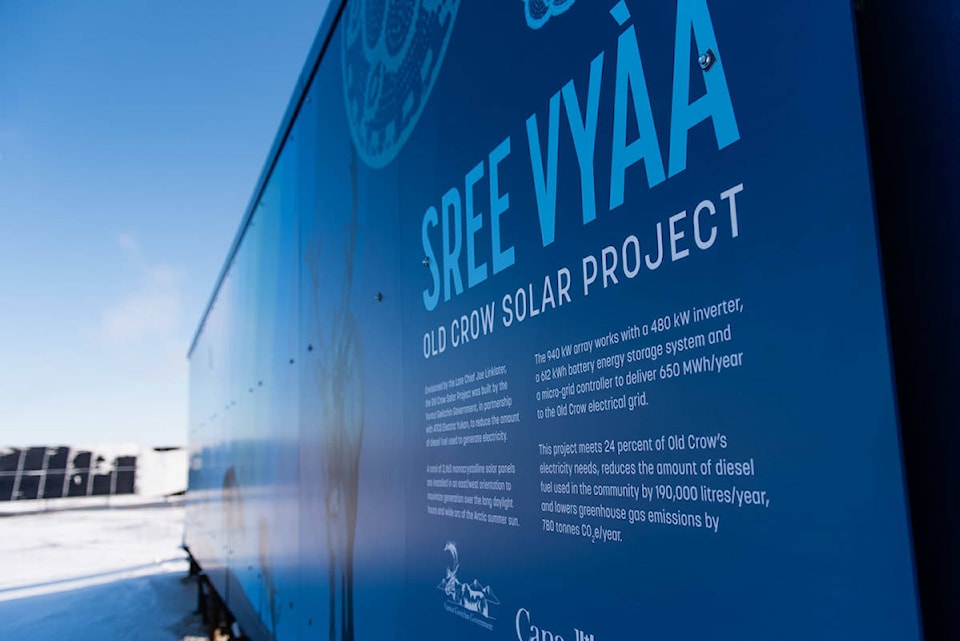The remote community of Old Crow is looking forward to a moment of silence.
The peace and quiet will result from the community’s diesel generators rumbling to a halt as a new solar panel array comes online to provide electricity in their place.
On May 3, the government of the Vuntut Gwitchin First Nation announced that the first stage of the solar project is up and running, generating electricity for the community 14 hours per day. Energy production is expected to trend upwards as the days grow longer in the subarctic community of approximately 250 people.
According to the Vuntut Gwitchin First Nation (VGFN), the solar project will reduce the amount of diesel burned to generate electricity for Old Crow by 190,000 litres each year once it is fully operational. This reduction is the equivalent of taking 160 cars off the road and it will reduce the community’s annual carbon emissions by 750 tonnes annually.
The first stage of the project has the solar array operating at approximately 12 per cent of its final capacity. Upcoming additions to the system, which will increase its power output, include a battery energy storage system and microgrid controller.
The second phase of the project is underway and work is expected to be complete by July. The fully operational system will produce enough electricity to meet the community’s full load allowing the diesel system to switch off completely on sunny summer days. As a result, the diesel system is expected to run for 2,000 hours less each than it might have otherwise.
Erika Tizya-Tramm, VGFN’s director of natural resources, said although the generators are pretty far away from most of the houses in Old Crow, she has heard from some residents that they find the generators quite loud.
According to a VGFN statement on the solar project, the move away from diesel power is consistent with their 2019 Yeendoo Diinehdoo Ji’heezrit Nits’oo Ts’o’Nan He’aa declaration. The declaration recognizes the planet’s climate crisis and the need to reduce greenhouse gas emissions.
VGFN Chief Dana Tizya-Tramm said the solar project allows Vuntut Gwitchin to show respect for the land and their traditions while creating opportunity for future generations.
“The Old Crow Solar Project presents an opportunity for our First Nation to take advantage of these technologies that embody our Gwich’in values of living in balance with our land in perpetuity,” he said.
Erika Tizya-Tramm said a changing climate has impacted the Vuntut Gwitchin’s traditional pursuits in a variety of ways. She said overall seasonal patterns become more unpredictable, manifesting in a variety of challenges: local hunters and trappers have encountered more difficulty traversing the land, greater risk of fire has threatened caribou habitat, some areas are flooding in the spring and salmon returns have diminished. Despite the difficulties, Tizya-Tramm said people are adapting and the VGFN is assisting when possible.
The Vuntut Gwitchin solar project was planned for completion last summer but delays related to the COVID-19 pandemic pushed it back.
Along with a clean source of power, the solar array will create a new stream of revenue for the First Nation, which has struck an electricity purchasing agreement with ATCO Electric Yukon. The agreement establishes that ATCO will purchase electricity generated at the facility.
Jay Massie, ATCO’s vice president of Northern Development Indigenous Relations, said helping customers in remote communities develop sustainable and renewable energy solutions is very important to ATCO. He added the company is proud of their long-running partnership with the Vuntut Gwitchin First Nation.
Solar isn’t the only renewable energy source Vuntut Gwitchin is hoping to use. Erika Tizya-Tramm said wind data is being collected to assess the possibility of a wind farm that could provide power in the dark winter months. She said a community energy plan for Old Crow is expected to be complete by the end of the year.
Erika Tizya-Tramm said the renewable energy work being done by the VGG has benefited from partnerships, Federal Government funding and networking with other communities in a similar situation. She said they are documenting their renewable energy work in hopes of sharing it with other communities looking for ways to limit dependence on fossil fuels.
Contact Jim Elliot at jim.elliot@yukon-news.com
